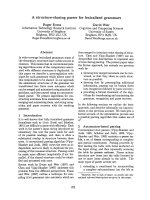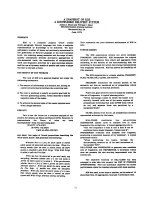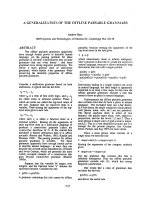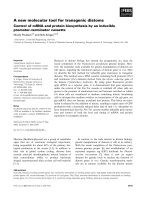Báo cáo khoa học: " A Type of Program for Mechanical Translation" ppt
Bạn đang xem bản rút gọn của tài liệu. Xem và tải ngay bản đầy đủ của tài liệu tại đây (172.39 KB, 5 trang )
[
Mechanical Translation
, vol.4, no.3, December 1957; pp. 54-58]
A Type of Program for Mechanical Translation
J. P. Cleave, University of Southampton, Southampton, England*
A program for the mechanical translation of a limited French vocabulary into Eng-
lish was constructed for operation on the computer APEXC. Its principal features
were an improved routine for dictionary look-up, and an organization permitting
systematic incorporation of additional subroutines. A program for syntactic
processing was constructed but was too large for the available storage space.
It examined preceding and following items — stems or endings — in order to
choose correct equivalents, and used a dictionary of syntactic sequences or
structures to effect local word-order change.
APEXC
The computer has a magnetic drum store
with 1024 locations arranged in 32 tracks each
of 32 locations. Each location contains 32 bits.
Any location can therefore be specified by an
address of 10 bits. Both data and instructions
are stored on the drum.
An instruction consists of 32 binary digits and
specifies an operation (function), the 10 bit ad-
dress of an operand contained in the store and
the address (10 bits) of the next instruction,
which again is contained in one location in the
store. The arrangement of the digits of an in-
struction is shown below (Fig. 1).
* This paper is a report of work done in
cooperation with Dr. A. D. Booth and Mr. L.
Brandwood at the Computational Laboratory,
Birkbeck College, London.
APEXC has one branch (jump) instruction
discriminating between positive (or zero) and
negative.
The following abbreviations will be used:
O
x
operand address (X-address) of an
instruction O.
O
y
next instruction address (Y-address)
of O.
(O
x
)
ls
least significant digit of O
x
(i.e.,
digit 10).
(O
y
)
ms
most significant digit of O
y
(i.e.,
digit 11).
(z) contents of the location whose address
is z.
Dictionary Subroutines
The dictionary procedure is best explained by
considering a simplified example with a diction-
ary of 16 positive entries stored in increasing
numerical order in locations 1, 2, 3, 16.
Suppose W is a word, known to be in the dic-
tionary, whose address in the dictionary is
required.
Program for MT
55
Figure 2
The bracketing procedure
1
requires us to start
in the middle of the dictionary, either at 8 or 9.
Suppose 8 is chosen; the procedure for 9 is
analogous (see Fig. 2).
An "operation" consists of forming W-(y) by
means of a subtraction instruction O. If the
result is positive, a "probe-number" p is added
to O
x
, if negative it is subtracted, p is then
divided by 2.
The first operation is on (8) (i.e., O
x
= 8)
with p = 2
2
. After the operation O
x
= 12 or 4
(i.e., O
x
= 8 + 2
2
or 8 - 2
2
), the new probe-
number is p = 2
1
.
The second operation gives a new probe-
number of 2
0
. The third test, therefore,
shows W to be in one of the 8 sets of 2 shown
in the diagram.
The fourth operation is slightly different from
those preceding. It can be seen that operations
1, 2, 3 each discriminate between two new ad-
dresses: the fourth discriminates between one
new address and one that has been tested before.
1. Booth, A. D., "Use of a Computing Machine
as a Mechanical Dictionary", Nature, vol. 176,
Sept. 17th, 1955, p.565.
If we now examine the dictionary entry specified
by O
x
at the beginning of operation 4, it can
be seen that W is either in O
x
or O
x
+1. (If
the initial location had been 9, the alternatives
would be O
x
and O
x
- 1.) Hitherto, dictionary
subroutines we have used counted the number of
operations performed and at the final operation
tested O
x
and its neighbor for identity with W.
This latter test had to be synthesized and so
required several instructions. This disadvan-
tage can be eliminated if the final operation is
similar to its predecessors.
Suppose operation 4 is similar to 1, 2, 3.
At the conclusion of the third test p = 2
-1
= 1/2. This is a '1' in (O
y
)
ms
. The X-
addresses formed are shown in Fig. 3.
If the initial location is 9 and (O
y
)
ms
prior
to operation 3 is '0', the correct address of W
in the dictionary will be formed in O
x
. But O
y
is the address of the next instruction to O in
the dictionary routine and is altered by the ad-
dition of 2
-1
to O
x
to O
y
' = O
v
+
2
9
, thus
enabling a jump to occur at precisely the right
moment in the sequence of operations. O
y
' is
the address of the first instruction of the rou-
tine following dictionary look-up. If the initial
56 J. P. Cleave
Figure 3
location is 8, W is located correctly only if
(O
y
)ms = 1 Here O
y
’ = O
y
-29
The efficacy of this method clearly depends
upon the fact that (O
x
)
ls
is next to (Oy)
ms
(see Fig. 1). This convenient arrangement now
enables us to dispense with special arrange-
ments for the final operation, counting the num-
ber of operations performed and special orders
for jumping to the next sequence. The diction-
ary program now occupies only 11 locations:
it was used in the MT program explained below.
If the W is not in the dictionary, then this
method of dictionary look-up will select the
greatest entry less than W.
It might be supposed that a further increase
of speed could be obtained if during each of the
above operations a test for zero is made (i.e.,
identity between W and the dictionary entry).
Suppose a dictionary of 2
n
entries. One dic-
tionary entry can be located during the 1st test,
2 during the 2nd, 4 during the 3rd, 2
r-1
during the r
th
, . . .; 2
n-1
+1 requires n tests.
(The extra 1 is an entry that cannot be located
by a zero test: in the examples of Fig. 2,
either 1, or 16.) Assuming that each entry
is equally likely to occur in a text, the average
number of operations to locate a single word is
m = [1.1 + 2.2 + 4.3 + . . . + r2
r-1
+ . . .
+ (n2
n-1
+ n)] /2
n
= n - 1 + (1 + n)/2
n
.
Thus if n is large only one operation is saved;
the extra programming required in a test for
zero is therefore not worth-while with a com-
puter without this facility.
The Basic MT Program
All data to be "recognized" were, with a few
exceptions, included in the main dictionary.
The input routine compared sequences of sym-
bols between "space" marks with the dictionary
entries. This routine therefore had only to rec-
ognize a "space" symbol on the input tape. All
punctuation marks, and the symbol for the end
of text, were included as dictionary entries.
Each dictionary entry D of the main- and
ending-dictionaries was confined to one storage
location and had two equivalents. The second
of these, E
2
, was the target language equiva-
lent of the dictionary entry. In general E
2
oc-
cupied several locations. All "syntactical"
operations were performed on the "first equiv-
alents, " E
1
, each of which occupied only one
storage location. Each E
1
was constructed
uniformly and consisted of three sets of ten
digits specifying addresses E
1
(l), E
1
(2), E
1
(3).
(See Fig. 4.)
Program for MT
57
dress E
1
(1) = S, the address of the initial in-
struction of a routine for processing the accu-
mulated data in S. (Fig. 5.) E
1
(l) for an
end-of-text symbol was ε
,
a stop order.
A program for processing the first equiva-
lents was constructed but was found to be too
large for the available storage space and was
abandoned. The plan of this routine, however,
will be stated.
The processing of S
1
consisted of carrying
out in turn the operations whose first instruc-
tions were determined by the second address
E
1
(2) of each first equivalent in S
1
. These
operations — condition routines — had two
functions. The first was to examine, where
necessary, equivalents preceding and following
to determine whether E
1
(3) specified the cor-
rect second equivalent. The second function was
to place a code number C corresponding to E
in another series of locations S
2
. Convenient
sub-sequences of the code numbers in S
2
were
then compared to a "structure-dictionary."
Recognition of these sub-sequences resulted in
a rearrangement of the order of the recognized
58 J. P. Cleave
C-sequence and the corresponding E
1
-sequence.
The code-numbers were therefore assigned in
such a manner that the sequences requiring re-
arrangement could be recognized distinctly.
Although in most cases this assignment coin-
cided with the usual classification of verb, pro-
noun, etc., there were some C which did not
correspond to these categories. Thus donn
was entered in the main dictionary, with 'give'
as the target language equivalent. The condi-
tion routine for this entry assigned a code num-
ber (verb
1
) to it. erons was an entry in the
verb-ending dictionary. The condition routine
determined by its first equivalent gave it a code
number (verb
2
). The second equivalent of
erons was 'will'. Thus when donnerons oc-
curred in the input text, the first equivalents of
donn and erons were placed in consecutive lo-
cations in S
1
. When the condition routines were
operated, the code numbers (verb
1
) and (verb
2
)
were placed in order in S
2
. Following these
routines the structure dictionary recognized
the sequence (verb
1
) (verb
2
) as one requiring
transposition. The corresponding data in S
1
were then transposed. Thus the final printing
operation printed the target language equiva-
lents of donn/erons in reverse order to yield
'will give'. This procedure was used to per-
form the pronoun-verb inversion.
The final stage of the program was a routine
for printing the second equivalents. In the pro-
gram which was put on APEXC the processing
of S
1
was omitted so that the dictionary rou-
tines were immediately followed by the print
routine. The print routine printed the contents
of the addresses specified by the 3rd address
of the first equivalents in S
1
. Each location
containing a second equivalent also contained
an indication of whether the content of the next
location was also to be printed. By this means
equivalents of any desired length could be
printed.
Some Characteristics of the Program
This program had two important features.
Firstly, all operations within the program
were carried out on the first equivalents. As
these were uniformly constructed, a greater
simplicity was achieved than if the foreign lan-
guage words or target language words had been
processed directly.
Secondly, the distinct parts of the whole pro-
gram were isolated, the linkages being supplied
by the addresses in the first equivalents. Thus
extra subroutines could be constructed and
linked to the program merely by altering ad-
dresses in the relevant first equivalents. For
instance, if a more refined condition routine
was necessary for a certain set of first equiva-
lents, this routine could be placed in the store
and the second addresses of the first equiva-
lents altered to the address of the initial order
of the new routine.
The size of storage in the computer imposed
severe limits on the extent and performance of
the program. Thus very small dictionaries
were used, although best use was made of the
space available by means of stem-ending split-
ting. Apart from these faults, there were two
inherent drawbacks of the above type of program.
The use of separate condition routines em-
ploying a matching procedure to examine the
minor context of a first equivalent lead to an
excessive program. A more economical ap-
proach would be to calculate correct alterna-
tives from code numbers by some means. This
would greatly reduce the storage space as-
signed to this particular part of the program.
Secondly, the method of effecting change of
word order appears to be applicable only to
subsections of languages where permutation of
target language order into foreign language
order is purely local. Thus if a set of n con-
secutive code numbers in S
2
was matched by
the above method to a dictionary of structures,
the change of word order was confined to the
corresponding set of n first equivalents only.
This process was clearly incapable of dealing
directly with rearrangements of blocks of words.
A possible solution of the problem here would
be to use two structure-dictionaries, one for
permuting elements within a block, another to
permute the blocks. The necessity of using a
structure-dictionary will disappear when a suit-
able technique of calculation (as opposed to
matching) has been discovered.









